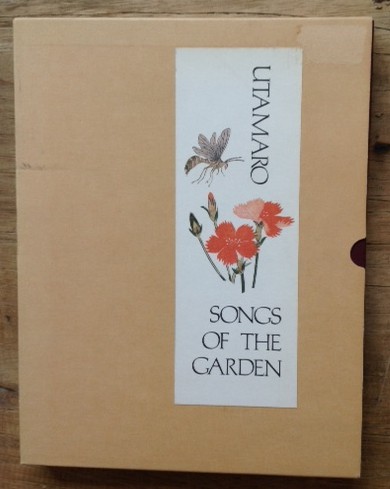Inspiring Older Readers
 posted on 02 Sep 2017
posted on 02 Sep 2017
Songs of the Garden illustrated by Utamaro Kitagawa
Comparatively little is known about the life of the great Japanese artist Utamaro (1750 – 1806) who was born Ichitaro Kitagawa but adopted the name Utamaro some time around 1780. He’s probably best known for being one of the great print makers of the Edo period, using subjects drawn from what is often called ‘The Floating World’ – the neighbourhoods occupied by courtesans, the poor and the fringe criminals.
His fantastically delicate and sensitive work documenting the natural world is much less well known but his ‘Book of Insects’ marks an important moment in the development of his career. Although the title suggests the focus of this work is insect life, it is in fact a much more comprehensive capturing of nature in all its manifestations. The drawings are now prized as some of the finest and most unorthodox illustrations to come out of Japan at that period.

The Metropolitan Museum of Art in New York who have reproduced Utamaro’s work in faithful and glorious facsimile have this to say about the book:
Although this book is now treasured for its illustrations, it was originally designed not simply as a picture book but as an anthology of specially commissioned poems on the subject of insects. In fact, the verses composed for each plate, new translations of which appear at the back of this volume, are appropriate poetic companions to Utamaro's unorthodox drawings. Yadoya no Meshimori, who compiled the poems and wrote the preface, was the leader of the kyōka (comic verse) movement, which emerged as a reaction against rigid classical traditions and allowed for great freedom of subject and style, for the poems often incorporate humorous or amorous undertones. In his preface Meshimori reveals that the idea for a selection of poetry based on the theme of love but apparently devoted to insects occurred to him and his friends as they sat listening to crickets and cicadas along a riverbank, an activity popular as early as the tenth century in Japan but given new life here as the poetic form and theme depart radically from tradition.

The original manuscripts were produced as two separate volumes bound in an interlinking way so that the illustrations would form almost single double-page spreads and this facsimile reproduces this. Instead of a traditional book bound page after separate page we get a concertina effect of fabulous drawings that fold out one after another with translations of the poems following at the end.
When these extraordinary subtle and understated illustrations and poems found their way to Europe the impact on Western art and interior design was immediate and remarkable. The Aesthetic Movement took many of Utamaro’s themes and techniques and blended them with their own sensibilities to produce something unique and highly decorative.


The Met have done us all a tremendous favour by producing this wonderful facsimile, renamed The Songs of the Garden in a beautiful slipcase edition. You can pick up very good copies of this on the second-hand market for around £30 – which sounds like a big outlay but it is considerably cheaper than having to book your plane ticket to New York to take a look at the originals.
Terry Potter
September 2017

